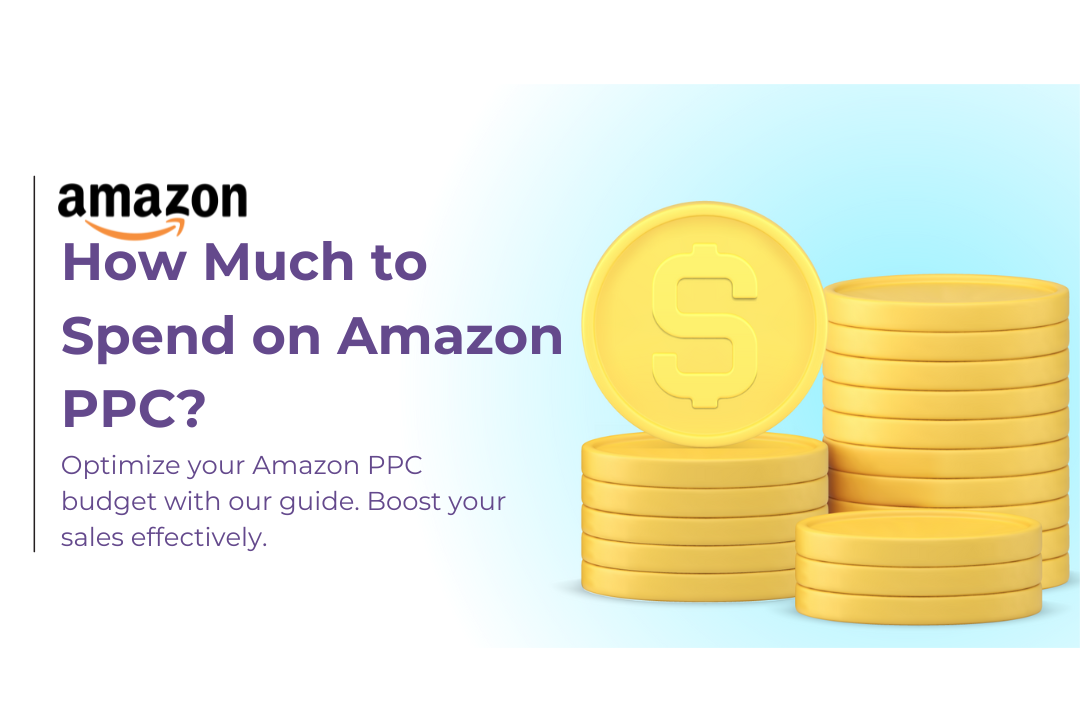Optimizing your product listings is only half the battle when selling on Amazon. To succeed in a competitive market, Amazon Pay-Per-Click (PPC) advertising is crucial for enhancing visibility and driving sales. However, a crucial question remains: How much should you spend on Amazon PPC? This complete & detailed guide will walk you through the factors that influence your PPC budget and how to determine the right amount for your business.
Table of Contents
ToggleUnderstanding Amazon PPC
Amazon PPC is a way for sellers to advertise on Amazon by paying for each click their ad receives. These ads appear in key Amazon locations, like search results and product detail pages. The aim is to make products more visible, increase traffic to listings, and ultimately increase sales.
Different types of Amazon PPC ads are available:
- Sponsored Products: Ads that promote individual listings.
- Sponsored Brands: Ads that feature your brand logo, a custom headline, and up to three products.
- Sponsored Display: Ads that target shoppers both on and off Amazon.
Before delving into budgeting, it’s essential to grasp the key factors influencing your PPC budget.
Factors Influencing Your Amazon PPC Budget
1. Product Margin: Your product’s profit margin is one of the most critical factors in determining your PPC budget. If you have a high-margin product, you can afford to spend more on advertising to gain visibility. Conversely, low-margin products require careful budget management to avoid eating into profits.
Consider this: If your product sells for $50 and has a margin of $20, you can allocate a higher PPC budget. However, if your margin is only $5, your PPC spend needs to be more conservative.
2. Advertising Goals: Your specific goals will also dictate your PPC spending. Are you aiming for brand awareness, or are you focused on maximizing sales? If you’re launching a new product, you might spend more initially to build momentum. A sustained PPC campaign might be necessary if you’re targeting repeat customers or increasing your market share.
For example, if you aim to launch a new product, consider initially allocating a larger budget and reducing it as the product gains traction. On the other hand, if your goal is to maintain sales for a best-seller, a consistent but moderate budget might be more appropriate.
3. Keyword Competitiveness: The competitiveness of your chosen keywords can significantly impact your PPC budget. High-competition keywords like “organic coffee” or “wireless earbuds” require a higher bid to win ad placements. In contrast, less competitive long-tail keywords may allow you to achieve visibility with a lower spend.
It’s important to perform comprehensive keyword research to balance high-traffic and low-competition keywords. Tools like Amazon’s Keyword Planner and third-party tools such as Helium 10 can help you identify the most cost-effective keywords for your campaign.
For more insights into optimizing your product listings and selecting the right keywords, check out our article on how to add variations to an existing Amazon listing.
4. Average Cost of Sale (ACoS): ACoS is a metric that shows how much you spend on ads to generate $1 in sales. It’s calculated by dividing your ad spend by the sales generated from ads. The lower your ACoS, the more profitable your ad campaign.
An ACoS of 20% means you’re spending $0.20 on ads for every $1 of sales. The ideal ACoS depends on your product margin and advertising goals. High-margin products can afford a higher ACoS, while low-margin products require a lower ACoS to stay profitable.
Learn more about managing your Amazon ACoS effectively in our comprehensive guide to earning the Amazon Choice badge.
How to Determine Your Amazon PPC Budget
1. Calculate Your Break-Even: The first step in determining your PPC budget is to calculate your break-even ACoS. This is the ACoS at which you neither make nor lose money. It’s calculated by dividing your profit margin by your selling price.
For example, if your profit margin is $10 on a $50 product, your break-even ACoS would be 20%. Knowing your break-even ACoS helps you set a realistic PPC budget that aligns with your profitability goals.
2. Set a Daily Budget: Amazon allows you to set daily budgets for your PPC campaigns. This budget caps your spending, ensuring you don’t exceed what you’re comfortable with. A good starting point is to set your daily budget at 10-15% of your product’s profit margin.
If your profit margin is $20, you might start with a daily budget of $2-$3. Feel free to modify your budget as you track your campaign’s performance.
3. Monitor and Adjust Your Spend: PPC campaigns require constant monitoring and adjustment. Review your campaign data to identify which keywords and ads are performing the best. If a particular keyword generates high sales at a low ACoS, consider increasing your budget for that keyword.
Conversely, if certain keywords are underperforming, reduce your spending or pause them to allocate your budget more effectively.
Discover more strategies for optimizing your Amazon PPC campaigns in our article on how to increase book sales on Amazon.
4. Consider Your Total Advertising Cost of Sale (TACoS): TACoS considers your organic sales in addition to sales generated through PPC. ROI is calculated by dividing your total ad spend by your total sales, including organic sales. A lower TACoS indicates that your organic sales are strong and your PPC campaign is effective.
If your TACoS is high, it might indicate that you’re too reliant on PPC, and you should focus on improving your product listings and organic rankings. For tips on enhancing your organic sales, check out our guide on creating passive income with Amazon Kindle.
5. Scale Your Budget with Caution: As your business grows, you may be tempted to increase your PPC budget. While scaling is necessary, it’s essential to do so cautiously. Rapidly increasing your budget without analyzing the performance data can lead to overspending and reduced profitability.
A good approach is to scale your budget incrementally, monitor the impact on your ACoS and TACoS, and adjust based on the data. Remember, the goal is to maintain profitability while increasing sales.
For more on scaling your Amazon business, explore our detailed guide on flipping Amazon deals for profit.
Real-World Examples of Amazon PPC Budgets
To better understand how much to spend on Amazon PPC, let’s look at some real-world examples:
- Example 1: New Product Launch: A seller is launching a new kitchen gadget with a profit margin of $15. Their goal is to gain visibility and generate sales quickly. They set a daily PPC budget of $5, targeting long-tail keywords with lower competition. Over the first month, they adjust their budget based on performance data, eventually increasing it to $10 per day as the product gains traction.
- Example 2: Established Best-Seller: A seller with a best-selling fitness product has a profit margin of $25. They have an established organic presence but want to maintain visibility. They set a daily PPC budget of $3, focusing on high-conversion keywords. Their consistent sales allow them to maintain a low ACoS and allocate more of their budget to other products.
- Example 3: Seasonal Product: A seller has a seasonal product with a high margin during the holiday season. They increase their PPC budget to $20 per day during peak sales periods and reduce it to $5 per day during off-peak months. This strategy allows them to maximize profits during high-demand periods while controlling costs during slower months.
Frequently Asked Questions
How much should I budget for Amazon PPC?
Budget 10-15% of your product’s profit margin as a starting point for daily Amazon PPC spending, then adjust based on performance.
How much money should I spend on Amazon ads?
Spend enough to achieve your advertising goals while maintaining profitability. It’s common to start with a conservative budget and then increase it as you see positive returns, although this can vary.
How much do you spend on PPC?
Your business objectives, product profit margins, and market competition determine the amount you invest in PPC. It’s common to start with a daily budget and adjust based on your ACoS (Average Cost of Sale) and sales performance.
What is spent on Amazon PPC?
Spending in Amazon PPC refers to the total amount you pay for clicks on your ads. This spending impacts your overall ad performance and profitability.
Final Thoughts
The amount spent on Amazon PPC varies and isn’t a one-size-fits-all approach. It requires carefully analyzing your product margins, advertising goals, keyword competitiveness, and overall business strategy. By setting a realistic budget, monitoring your campaign performance, and making data-driven adjustments, you can optimize your PPC spending to drive profitability.
Whether launching a new product or maintaining a best-seller, Amazon PPC can be a powerful tool in your marketing arsenal. For more personalized advice on Amazon PPC and other e-commerce strategies, visit our services page at ecommstars.com.
And don’t forget to explore our other resources:
- How to Sell Supplements on Amazon
- How to Sell Food on Amazon: A Comprehensive Guide
- How to Reinstate Your Amazon Account
By following the tips outlined in this guide, you’ll be well on your way to optimizing your Amazon PPC campaigns and achieving your sales goals.






